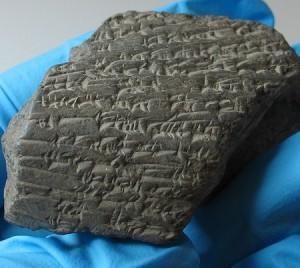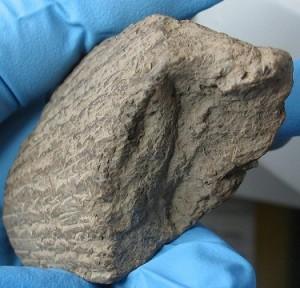An ancient Babylonian souvenir?

One of the more unusual items to be found in the Memorial's collection is the item shown above. It was purchased by an Australian soldier, Eric Keast Burke, while he was serving with 'D' Troop, ANZAC Wireless Squadron in Baghdad, Mesopotamia in 1918-1919 and was originally identified as a piece of an ancient Babylonian cuneiform tablet.
Demonstrating the strong interest in archaeology and architecture he developed while serving in Mesopotamia, Burke collected a number of other items there: A fragment of tile from an unknown shrine in Baghdad; a piece of coarse marble from the ancient Assyrian city of Nineveh; basalt he thought might have come from the sacred way in Babylon; and black pitch used as mortar in 'Nebuchadnezzar's Babylon' (possibly Nebuchadnezzar II who ruled from 605 to 562 BCE).

When I first saw this item and held it, I was pretty excited. To hold something so ancient was a thrill and Burke may have felt the same way. However, I knew there was always the possibility it was not a real antiquity so I contacted an expert in cuneiform tablets at the British Museum, who, after studying several images of the item, noted that some of the script seemed to be the wrong way round. He also noted that the surface was curved and looked as if it could have come from a cylinder rather than a tablet. Cylinders were generally used for royal inscriptions and were carefully inscribed - this item was not and after further assessment he confirmed it is a fake.
Eric Keast Burke with the ruins of a lion standing over a prostrate man roughly carved in black basalt, 1919.
Strangely enough this did not disappoint me. In fact I thought it was an even more interesting item. Fake tablets have been made and sold in Mesopotamia since the early nineteenth century, when the area was 'rediscovered' by archaeologists, diplomats and tourists. While not as large as the famous Egyptian trade in fake antiquities, the trade in fake 'Babylonian' tablets was still a decent money earner - especially during the war, when thousands of soldiers made their way through Mesopotamia. This 'Babylonian tablet' certainly is one of the more unusual souvenirs collected during the war and despite not being a genuine antiquity it is still one of my favourites.
Soldiers explore the ruins of the ancient city of Babylon in Mesopotamia c 1919.


